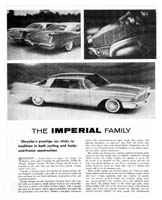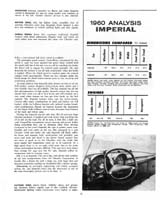


Larger, printable version |

Larger, printable version |
|
MOTOR LIFE, November, 1959 (Page 64-65)
"THE IMPERIAL FAMILY" Tradition, a strong factor in luxury car design, played a great part in shaping the 1960 Imperial. Unlike radically changed Chrysler, DeSoto, Dodge and Plymouth, it continues as the same basic car that has been gaining a larger market since 1957. Though it contains many innovations and improvements, the new Imperial is essentially a face lift of the previous model and does not share the unit body-and-frame construction of its 1960 corporate brothers. Styling changes are still impressive; interiors favor lush comfort with an attention to detail seldom found in any automobile. Seats have as much as six inches of foam rubber, with a separate seat back for the driver which supports shoulders and spine like few production cars ever have. There's a non-glare instrument panel with electro- luminescent light (metal dials coated with glowing phosphor), an improved auto pilot and swivel seats that chase doors open and closed. Series designations are the same as 1959 (Custom, Crown and LeBaron) as a re engine capacity and major exterior dimensions. Best of the new features are a double padded instrument panel, improved seat belt design and a wonderful emergency warning flasher system. No matter whether the ignition is on or off, the owner of an Imperial can flip a special switch and start all four turn signals flashing on and off as a warning to oncoming traffic. Borrowed from the truck lines, this is a feature that could well be on all passenger cars. Some styling changes are obvious, others not. There are satin-finish stainless steel inserts on the roof of LeBaron models, which also have a sharp appearing small rear window for greater rear seat privacy in both sedans and hardtops. Inside there are power operated vent windows and a new elliptical steering wheel. The unique shape of the wheel and spoke placement permits a full view of the instrument panel, while flattened upper and lower areas provide greater leg clearance and improved forward visibility for short people. For old fashioned folks, a conventional full circle wheel is available. The automatic speed control (Auto-Pilot), introduced by Imperial in 1958, has been updated but good. Early models held the speed well, but if the unit was cut off by touching the brake, the driver had to engage the control again manually. On 1960 Imperials the control is cut off only temporarily when the brake is applied. When the dialed speed is reached again, the control engages itself automatically. There are few changes under the hood, except for detail improvements made to ease servicing and production problems. As usual, interior trim materials seem almost too nice to sit on. Full leather, custom designed nylon-viscose body cloths and a new doeskin vinyl [NOTE: ??? May be in same category as flashers] are all available. The last material has all the feel and appearance of high quality chamois, except that the nap doesn't fuzz when you rub it. It is lovely and will certainly set a new trend when custom car fans get their hands on the bolt material. The Imperial Custom series uses the nylon-viscose, Crowns offer combinations of cloth and leather (or full leather) while the LeBaron features soft, tailored woolen broadcloth combinations. Deeply set buttons increase the impression of rich depth while LeBaron coat of arms decorates head bolsters of the back and driver seats. Driving the Imperial proved only that, like all previous large Chrysler products, it handled and rode better than anything else of its size on the road. For all its mass, it feels like a light car, with TorqueFlite transmission, power steering and power brakes doing everything they can to eliminate labor from driving. Compared to last year's Imperial, the 1960 is quieter, more comfortable, and even easier on the eye. But compared to a 1960 Chrysler (with unit body), the 1960 Imperial will likely suffer. Its frame and separate body construction will probably pass more road noise and shock to the driver. Sound control does not seem as good as on the Chrysler, with the result that more engine and transmission noise are to be expected. At a high speed, from 75 to 100 mph, wind noise rises to the point where conversation becomes difficult. This may have been better than average for 1959 cars, but for 1960, Imperial suffers by comparison with its running mates. Still, it is an Imperial. The car is big, with all the lush comfort of our best transportation from the Chrysler Corporation. It handles like a dream for such a large car, with huge tires and measured suspension soaking up chuckholes like a thirsty sponge. Maintaining its successful engineering and widely accepted styling, the 1960 Imperial comes into the showroom as one of the most thoroughly proven cars in its class.
|